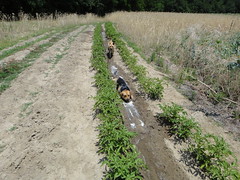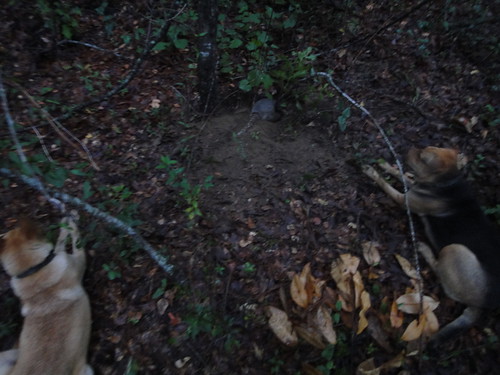Oh, right: the yard armadillo. It’s digging in, making noises like a hog: Continue reading
Author Archives: John S. Quarterman
Bathing dog
Sweet potatoes
Hydrometer 1.011
Lowndes County farms small and increasing
Farms in Lowndes county are mostly small, averaging 145 acres, with the largest category being 10-50 acres.
Of course, that’s slightly misleading since so many small farms are rented by a few larger operators, some based in other counties. Still, small farms are the easiest to wean off the pesticide teat. Given that the average age of principal farm operator in Lowndes County is 57.9, something is likely to change soon as many of those operators retire.
We already know that local farming is linking up with local markets through Hahira’s summer farmers market, which has been going on for years, increased farmers markets, and through the new Downtown Valdosta Farm Days. That looks like a good direction.
-jsq
Dogs helping with white potatoes
 Brown dog and yellow dog see mud.
They know what to do!
Brown dog and yellow dog see mud.
They know what to do!
Brown dog likes to drink it.
They both like to wallow in it. Continue reading
Small farms increasing
Christopher Wanjek wrote in LiveScience 10 February 2009, Small Farms Sprout in Economic Drought:
We know this works elsewhere:When the economy gets tough, it seems that the tough get farming. Tens of thousands of small farms were created since 2002, according to new data from the Census of Agriculture.
The farming forecast isn’t entirely sunny. But packed with a cornucopia of surprise findings — such as large increases in the number and percentage of Asian, Hispanic, Black and female farmers, and a coup staged by the frigid state of Wisconsin to become the second-leading vegetable producer, behind California — the census brings promising news to those interested in reducing obesity and improving the environment.
What’s the connection? More small farms brings greater diversity of crops, more fresh and local foods, less dependency on chemical fertilizers, less concentration of manure, and less emphasis on cheap corn to make unhealthy, industrially produced beef, pork and chicken.
In Japan, were obesity is negligible and the population lives on average about five years longer than Americans do, most cities and their surroundings are filled with small farms. Farmers south of Tokyo, which has a climate similar to Washington, work year round, planting winter crops such as broccoli and hearty greens, which are then picked and delivered to local stores within a day or two. The system is called chisan, chishou, “produce local, consume local.”Unfortunately, big farms also increased during the same period, and mid-sized farms decreased. Basically, mid-sized farms can’t compete in the pesticide game, and are being absorbed by huge corporate farms while being a grass-roots movement of small farms is coming up from the bottom.
Rather than massive Monsanto farms, I choose chisan, chishou.
-jsq
Gretchen digging lots of potatoes
 Gretchen digging the potatoes she’s selling today at
Downtown Valdosta Farm Days.
Gretchen digging the potatoes she’s selling today at
Downtown Valdosta Farm Days.
Look at the roots on that thing!
Hundreds of pounds of potatoes: Continue reading
More profit and higher yields through organic farming in India
Increase your income and your yields with traditional farming methods? That’s what’s happening in India.
Nishika Patel blogged 11 May 2011 in The Guardian, Organic farming – India’s future perfect?
How did this happen?India’s struggling farmers are starting to profit from a budding interest in organic living. Not only are the incomes of organic farmers soaring – by 30% to 200%, according to organic experts – but their yields are rising as the pesticide-poisoned land is repaired through natural farming methods.
Organic farming only took off in the country about seven years ago. Farmers are turning back to traditional farming methods for a number of reasons.Continue readingFirst, there’s a 10% to 20% premium









